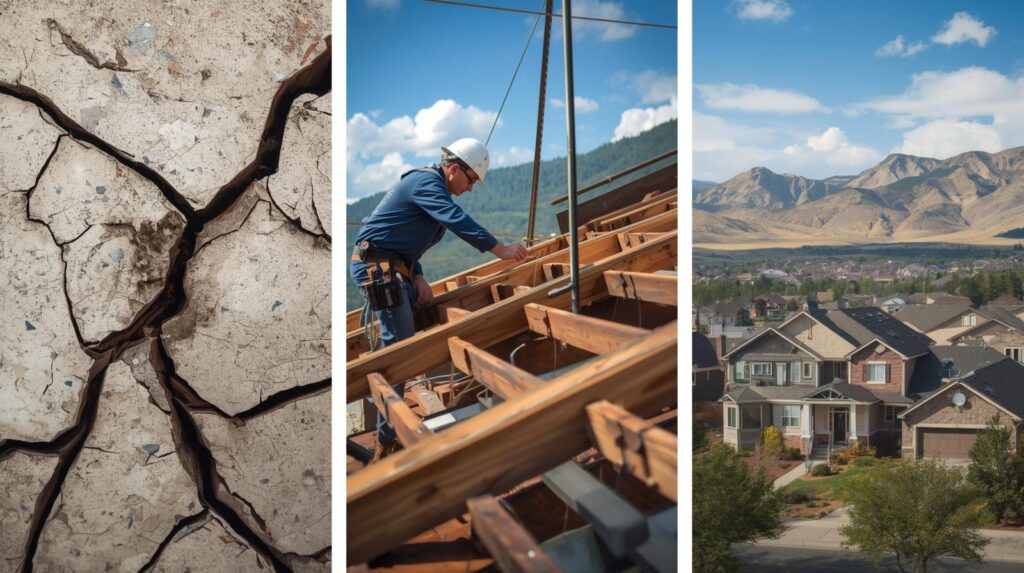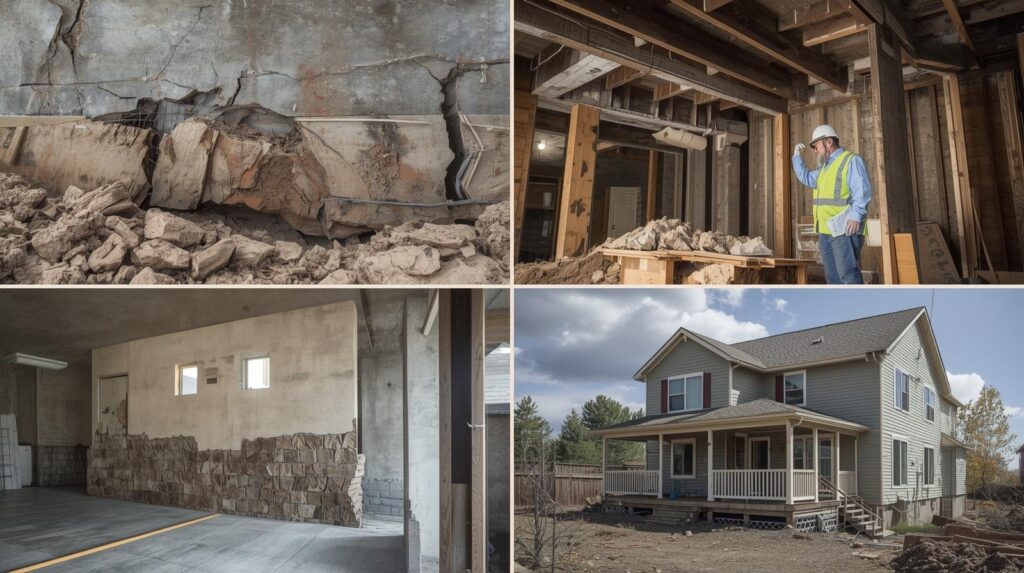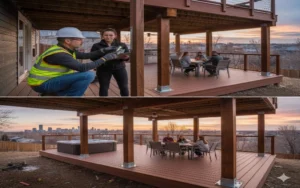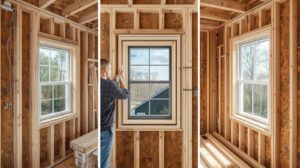Living in Colorado’s Front Range means enjoying mountain views and outdoor recreation, but it also means being in a moderate seismic zone with real earthquake risks. When the ground shakes, your home’s structural integrity becomes paramount. A thorough earthquake structural inspection can mean the difference between minor repairs and catastrophic failure. This comprehensive guide explores the critical signs of structural damage after seismic events and provides homeowners with the knowledge needed to assess their property’s safety. Understanding what to look for—and when to call a professional—can protect your family and your most significant investment when the unexpected occurs.
Why an Immediate Earthquake Structural Inspection is Critical
The Hidden Dangers of Seismic Damage
Many homeowners make the dangerous assumption that if their building appears intact after an earthquake, no significant damage has occurred. However, seismic forces can create hidden weaknesses that compromise structural integrity, only becoming apparent during subsequent tremors or even normal weather conditions. A professional earthquake structural inspection identifies these latent issues before they escalate into safety hazards. In one notable case following the 2011 earthquake in Trinidad, Colorado, our post-earthquake assessment revealed subtle foundation shifts that had gone unnoticed by the homeowners but would have led to structural collapse during the next significant seismic event.
Understanding Colorado’s Seismic Risk Profile
While Colorado isn’t California, our state experiences hundreds of earthquakes annually, with several significant historical events causing substantial damage. The Front Range urban corridor sits near several active fault lines, and Denver specifically faces amplified risk due to the deep sedimentary basin beneath the city that can magnify seismic waves. This geological reality makes a proper earthquake structural inspection just as relevant for Denver homeowners as for those in traditionally high-risk areas. Understanding your specific risk level begins with recognizing that earthquake damage can occur even from minor tremors, especially in older homes not built to modern seismic standards.
Conducting Your Initial Earthquake Structural Inspection
Exterior Signs of Structural Damage After an Earthquake
Begin your earthquake structural inspection outside the building, where many telltale signs first appear. Walk the perimeter looking for new cracks in exterior walls, particularly stair-step cracking in brick or masonry that indicates foundation movement. Check for gaps between the soil and foundation that weren’t present before, and inspect chimney structures for leaning or separation from the house. During a seismic damage inspection in the Capitol Hill neighborhood following minor tremors, we discovered a partially collapsed chimney that posed an immediate danger to pedestrians below—a risk the homeowners had completely missed in their own assessment.
Interior Indicators Requiring Professional Earthquake Structural Inspection
Inside your home, a systematic earthquake structural inspection should focus on key structural elements. Look for doors and windows that no longer open properly, which can indicate frame distortion. Check for cracks radiating from window and door corners, and examine walls and ceilings for new cracking patterns. Pay special attention to the basement or crawlspace, where early signs of foundation damage often appear. Horizontal cracks in foundation walls are particularly concerning, as they indicate soil pressure that could lead to collapse during future seismic events. These interior signs often provide the clearest evidence that professional assessment is needed.
Foundation Assessment After an Earthquake

How to Assess Foundation After an Earthquake Methodically
The foundation is your home’s most critical structural component, and learning “how to assess foundation after an earthquake” requires a systematic approach. Begin by checking for visible cracks, noting their width, length, and direction. Horizontal cracks often indicate more serious issues than vertical ones. Look for sections of the foundation that have shifted or sunk, using a level to check for tilting. In a recent post-earthquake assessment in the Highlands neighborhood, we employed laser levels to detect subtle foundation settling that wasn’t visible to the naked eye but would have led to significant structural problems over time.
Understanding Different Foundation Damage Types
Not all foundation damage is equal, and a proper earthquake structural inspection categorizes issues by severity. Hairline cracks (less than 1/8 inch) may only require monitoring, while cracks wider than 1/4 inch typically indicate significant movement needing repair. Differential settlement, where one part of the foundation sinks faster than another, presents particular concerns in seismic regions. This type of damage often requires specialized foundation repair techniques like piering or slabjacking to restore structural integrity. Understanding these distinctions helps homeowners prioritize repairs and allocate resources effectively.
Structural Components Vulnerable in Earthquakes
The Critical Role of Cripple Wall Bracing in Seismic Performance
Cripple wall bracing represents one of the most important yet overlooked elements in earthquake resistance. These short walls between the foundation and first floor act as the structural connection between your home and its base. Without proper cripple wall bracing, homes can slide off their foundations during seismic events—a common failure mode in older Denver homes. During our seismic damage inspection services, we frequently find inadequate or deteriorated bracing that leaves homes vulnerable. The good news is that cripple wall bracing represents one of the most cost-effective seismic upgrades available to homeowners.
Assessing Framing and Connection Points
Beyond the foundation, a comprehensive earthquake structural inspection examines the wood framing and connection points throughout the structure. Look for split or cracked framing members, particularly around openings and at connections between vertical and horizontal elements. Check that the house is properly bolted to the foundation—a requirement in modern construction but often missing in older homes. In one post-earthquake assessment of a 1920s bungalow in Baker, we discovered that the entire structure was resting on the foundation by gravity alone, with no positive connections—a discovery that explained the significant movement during minor tremors.
When to Call a Structural Engineer for Earthquake Damage
Immediate Red Flags Requiring Professional Earthquake Structural Inspection
Certain conditions unequivocally answer the question of “when to call a structural engineer for earthquake damage.” These include: visible foundation shifting or settlement, large cracks in walls or foundations (especially horizontal ones), doors or windows that no longer function properly, sloping floors, and visible separation between building components. Any of these signs warrant immediate professional earthquake structural inspection. Following the 2020 earthquake near Ridgway, we encountered a home with a 2-inch foundation separation that the homeowners had dismissed as “settling”—a dangerous misinterpretation that required emergency shoring until permanent repairs could be made.
The Professional Earthquake Structural Inspection Process
A professional earthquake structural inspection conducted by a qualified structural engineer follows a meticulous process that goes far beyond visual assessment. This typically includes detailed measurement of cracks and displacements, laser leveling to detect subtle foundation movement, and potentially non-destructive testing to evaluate the condition of hidden structural elements. The engineer will document all findings in a comprehensive report that includes specific repair recommendations and prioritizes issues by safety concern. This process mirrors the thorough approach we take in all our Structural Design Process of a Residential Building projects, adapted to post-earthquake conditions.
Seismic Retrofit Considerations After Earthquake Structural Inspection

Understanding Seismic Retrofit Options
Following an earthquake structural inspection, many homeowners consider retrofit options to improve their home’s seismic performance. Common retrofit measures include adding foundation bolting, installing cripple wall bracing, reinforcing masonry chimneys, and securing water heaters. The specific retrofit recommendations will depend on the home’s construction type, age, and the findings of the structural inspection. In many cases, these improvements can be implemented relatively inexpensively compared to the cost of repairing earthquake damage. Our approach to Residential Structural Engineering Services includes developing cost-effective retrofit strategies tailored to each home’s specific vulnerabilities.
Balancing Repair vs. Retrofit Decisions
After completing an earthquake structural inspection, homeowners often face the dilemma of whether to simply repair damage or invest in comprehensive retrofit. This decision involves considering the home’s value, the cost of repairs, likelihood of future seismic events, and potential insurance implications. In general, if significant repairs are already needed, adding retrofit measures often represents a small incremental cost that provides substantial additional protection. This decision-making process requires the same careful analysis we apply to complex projects like Column Removal in Buildings or Adding a Floor to an Old Building.
Financial and Insurance Considerations
Navigating Insurance After Earthquake Damage
A professional earthquake structural inspection provides crucial documentation for insurance claims, clearly distinguishing between new earthquake damage and pre-existing conditions. Most standard homeowners policies exclude earthquake damage, requiring separate coverage. The detailed report from a qualified structural engineer becomes essential evidence when filing a claim, specifying the cause, extent, and repair recommendations for all documented damage. This professional documentation often makes the difference between a successful claim and a denied one.
Understanding the True Cost of Earthquake Structural Inspection and Repairs
Homeowners naturally wonder about the structural inspection cost following an earthquake. A comprehensive earthquake structural inspection typically ranges from $500 to $1,500 depending on the home’s size and complexity, while repairs can range from minor crack sealing to foundation reconstruction costing tens of thousands of dollars. When considering “should I repair or rebuild after an earthquake,” the decision typically hinges on whether repair costs exceed 50-60% of the home’s value. These financial considerations must be weighed against safety imperatives identified during the inspection process.
Frequently Asked Questions About Earthquake Structural Inspection
What kind of damage does an earthquake cause to a home?
Earthquakes can cause various damage types, from obvious issues like collapsed chimneys and cracked foundations to subtle problems like misaligned framing and compromised connections. The shaking can weaken structural elements, create settlement issues, and damage utility connections. A professional earthquake structural inspection identifies both apparent and hidden damage that could affect your home’s safety.
Is my home safe after a minor earthquake?
Even minor earthquakes can cause structural damage, particularly in older homes or those with pre-existing weaknesses. The only way to definitively answer “is my home safe after a minor earthquake” is through a professional earthquake structural inspection. Visible damage like cracked drywall or sticking doors indicates the need for immediate assessment, but the absence of visible damage doesn’t guarantee safety.
Should I repair or rebuild after an earthquake?
The “repair or rebuild” decision depends on the extent of damage, the home’s value, repair costs, and safety considerations. Generally, if repairs exceed 50-60% of the home’s replacement value, rebuilding may be more economical. However, sentimental value, historical significance, and insurance coverage also factor into this decision. A professional earthquake structural inspection provides the technical basis for this important choice.
How soon should I get an inspection after an earthquake?
A preliminary safety assessment should happen immediately if you suspect serious damage. A comprehensive earthquake structural inspection should be scheduled as soon as possible after the event, preferably within days or weeks. Prompt inspection ensures that hidden damage is identified before it worsens and provides documentation for insurance claims while evidence is fresh.
Conclusion
Earthquakes present real risks to Colorado homeowners, but knowledge and preparation can significantly reduce these dangers. A thorough earthquake structural inspection provides the foundation for making informed decisions about repairs, retrofits, and future safety. By understanding what to look for and when to call professionals, homeowners can protect their families and investments against seismic threats. Remember that the cost of inspection pales in comparison to the potential consequences of unaddressed structural damage.
Don’t wait until after the next tremor to wonder about your home’s structural integrity. The engineers at Ista Engineers specialize in comprehensive earthquake structural inspection services throughout Denver and the Front Range. From Residential Structural Engineering Services to Commercial Structural Engineering Services, we have the expertise to assess seismic damage and recommend appropriate repairs and retrofits. [Contact us today] to schedule your earthquake structural inspection because when the ground stops shaking, your peace of mind should just be beginning.




